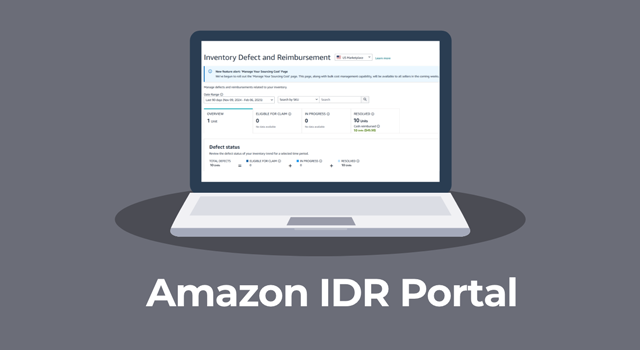While my own Amazon FBA business is still fully focused on private label products, I started a trial of flipping / arbitrage selling last year, using Henry, an Amazon Sharks member, as our guinea pig. Following on from his...
While my own Amazon FBA business is still fully focused on private label products, I started a trial of flipping / arbitrage selling last year, using Henry, an Amazon Sharks member, as our guinea pig.
Following on from his introduction to flipping post from last year where he covered the results of his first month flipping on Amazon UK, itís now the end of his first full year and time for another update.
So without any further ado from me, letís get to it!
Rather than make you wait until the end to find out, letís get straight to my final results and then Iíll work backwards and break it all down in more detail.
In total, from June 2021 to the end of May 2022 Ė I sold £100,520.82 with a profit of £25,755.21


Was I happy with this? Well Ė yes and no.
Flipping Expectations
When Andrew first asked me to try flipping / arbitrage selling as a test I was fairly hesitant. I imagined it being very time intensive and something more like an online job rather than a true Amazon FBA business.
It turns out on this front I was almost completely wrong.
Yes, flipping does require a lot of upkeep compared to private label and it is very time dependant BUT there are so many different models within flipping.
You have retail arbitrage, online arbitrage, Amazon to Amazon, seasonal items, long term holds, etc!
So donít make the mistake of thinking that flipping only means driving around tonnes of stores scanning items endlessly (not that thereís anything wrong with that sourcing model, plenty of people make good money with it).
But back to my point, and when I agreed to do this and document the results, I honestly would have been happy making £500 a month as a little extra side income.
So based on that Iím ecstatic with making over £25,000 profit! Especially when I consider how little time I really devoted to this.
But I also canít help being a bit disappointed because Iíve seen what the potential is with flipping and I know I could have made even more, especially as it was really the golden age of flipping with lockdowns and no holidays abroad.
This can be perfectly illustrated by going through my results month by month.


| Units Sold | Revenue | Profit | |
| Jun-21 | 31 | £7,252.00 | £1,881.57 |
| Jul-21 | 104 | £17,999.82 | £4,488.68 |
| Aug-21 | 130 | £17,784.68 | £4,209.78 |
| Sep-21 | 115 | £11,324.66 | £1,637.18 |
| Oct-21 | 15 | £2,764.46 | £335.69 |
| Nov-21 | 185 | £6,276.07 | £1,395.52 |
| Dec-21 | 449 | £13,093.85 | £3,756.40 |
| Jan-22 | 106 | £4,460.69 | £1,808.88 |
| Feb-22 | 206 | £7,806.95 | £2,836.30 |
| Mar-22 | 123 | £6,918.87 | £2,239.87 |
| Apr-22 | 43 | £1,971.33 | £671.76 |
| May-22 | 54 | £2,883.43 | £572.50 |
| Totals | 1561 | £100,536.81 | £25,834.13 |
The Amazon Cash Cow
As you can see I had an amazing start and in July and August, my first two full months, I made more than £4,000 profit each month!
If I had kept that going for the full 12 months I would have easily passed £50,000 profit for the year. But even at the time I knew that wouldnít be possible.
Why? Because my sales in those months were nearly all coming from one single productÖ
And with flipping this will never last. Sooner or later I knew other sellers would find that product and the price and margins would come crashing down.
After all you have to remember that this isnít like private label where you control the listing and are the only seller. With flipping youíre competing with tens and sometimes even hundreds of other sellers for any product and this invariably means that prices and margins come down over time.
Which is exactly what happened with this particular product for me and within a few months it wasnít even worthwhile selling it anymore.

In total I sold 314 units of this product, which accounted for a huge almost 40% of my total sales for the entire year.
And thatís the main reason for the drastic drop in sales and profit in September and particularly October, where I sold a paltry 15 units, making £2760 in sales and a measly £335 profit.
Thankfully I managed to bounce back from this big setback and in fact in December I was close to matching the highs of the summer months in terms of profit. This is mainly due to the fact that I had bought and held quite a few toys from the summer onwards and tried to time selling them during the Christmas rush, which led to some good returns.
Long Term vs Short Term Holds
However Iím not 100% convinced by this long hold strategy as often it didnít make sense from a pure ROI perspective.
If I buy a product for £100 and hold it for 4 months to get a 60% ROI, that sounds great right? Itís giving me a 3x higher return that if I sold a product for 20% ROIÖ
But really when youíre comparing ROI itís much fairer to look at your annualised return. Or to put it simply, if I can buy a product and sell it for a 20% ROI but do that on a monthly basis, then after 4 months Iíll have more than doubled my money.
That 60% ROI suddenly doesnít seem so great now does it (the power of compounding!)?
Of course to get a bit more advanced itís not quite as simple as that either as you still have to take into account your available funding (it might not be a question of a 20% short hold vs a 60% long hold if you have the money to buy both) and also obviously your time loss from dealing with more units.
Either way ROI is integral to a flipping business as it shows you how well youíre utilising your money, so Iíll be testing and tracking these different selling methods further this year.
FBM vs FBA
Another important point is that during this transition where I had to find new products to replace my green origami duck (side note Ė I love this presentation feature on Shopkeeper!) I also switched over from FBM to FBA and this made a huge difference to my business!
Going from having to package and post all orders myself to Amazon taking care of nearly all the work made everything so much easier. On top of the order fulfilment I also saved a tonne of time and stress not having to deal with customer queries and no longer worrying about my seller metrics (as itís very hard to mess these up when youíre selling via FBA).
Itís safe to say that I now truly appreciate what Andrewís been saying all these years about the dark days of fulfilling orders yourself on eBay and I will never go back to being majority FBM.
Thatís not to say I donít sell via FBM at all as it still has its place, mainly when youíre not 100% sure about a product and want to be able to return it if needed (one of the joys of flipping vs private label!) and also when itís just more cost effective (usually for larger items).
But as you can see these make up a small minority of my sales overall:

Increasing ROI with A2A Flips
Moving on from December and the Christmas boost and I saw an inevitable big drop in sales in January, but actually Q1 of 2022 was very consistent for me and my profit held up really well from January to March due to increasing ROI and margins.
You can see what a huge difference margin makes to your bottom line as while Januaryís sales fell a big 66% from December, actual profit was only just a little under 50% less.
| Revenue | Profit | Margin | |
| Jun-21 | £7,252.00 | £1,881.57 | 26% |
| Jul-21 | £17,999.82 | £4,488.68 | 25% |
| Aug-21 | £17,784.68 | £4,209.78 | 24% |
| Sep-21 | £11,324.66 | £1,637.18 | 14% |
| Oct-21 | £2,764.46 | £335.69 | 12% |
| Nov-21 | £6,276.07 | £1,395.52 | 22% |
| Dec-21 | £13,093.85 | £3,756.40 | 29% |
| Jan-22 | £4,460.69 | £1,808.88 | 41% |
| Feb-22 | £7,806.95 | £2,836.30 | 36% |
| Mar-22 | £6,918.87 | £2,239.87 | 32% |
| Apr-22 | £1,971.33 | £671.76 | 34% |
| May-22 | £2,883.43 | £572.50 | 20% |
| Totals | £100,536.81 | £25,834.13 | 26% |
This was achieved by focusing more on Amazon to Amazon flips which I saw a lot of success with on a few products in particular. But donít worry, it was still a good mix of profit and not overly reliant on a single item like before.

If I could go back in time I would have bought hundreds of the top two products as they were easily selling multiple units a day with a great profit per unit and more than a 100% return on cost price!

But unfortunately at the time I didnít quite have enough knowledge and experience to go all in with these.
Unlimited Amazon Buying Account
And sadly as Q1 drew to a close another slight reinvention became necessary as I lost my unlimited purchasing on Amazon!
As youíve probably already seen, as a buyer most products on Amazon have order limits preventing you from buying in bulk.

For a while I didnít have these and could pretty much order as many of each product as I wanted and this of course helped hugely when I focused on Amazon to Amazon sourcing.
But in typical inexplicable Amazon style (nobody really knows for sure why some accounts get unlimited order quantities) the order limits came back on my account. And once again the effect of this can be seen by the drop in sales and profit in April and May, ending my first full year on a slightly negative note.
Projections and Goals for the Year Ahead
However I am not deterred and after seeing the potential of flipping I am determined and quietly optimistic that I can match and surpass my first year.
Some months will be undoubtedly hard to match but I should definitely be more consistent overall.
Looking back and the most vital point for me in year 2 is to avoid the big slow downs in certain months due to my overreliance on certain products and sourcing methods.
I plan to avoid this happening again but focusing a lot more on replens (items that you can sell again and again) and crucially Ė sorting out my storage issues!
Space was a huge limiting factor for me as I would order products, fill up my space, and then not be able to order anything until I sent off / sold my current stock.
This of course meant pausing my spending for periods at a time and in flipping, spending = profit at the end of the day, so fixing this storage problem is my no.1 priority.
I have a few different options here:
Add storage to my houseGet a storage unitUse a prep center1 is obviously my preference due to it being the lowest cost overall, but itís not that feasible living in London with a tiny garden!
That leaves options 2 & 3 which will both cut into my margins and profit. But I already made the mistake of ďsaving moneyĒ on this and then losing out on significantly more sales and profit by not having the space.
And a prep center will not only help with that but it will also save me time, which again is a key part of my targets for year 2.
Outsourcing
My goal with flipping has always been to spend as little time as possible on it while maximising profit and the two key areas I can do this moving forward are:
Outsourcing prepOutsourcing purchasingThat means a prep center and a VA (virtual assistant) are integral parts of my plans looking ahead at year 2 and I will cover the options and costs here in more detail in further dedicated blog posts.
Overall I am very pleased with my results and am extremely excited to grow this business (and yes, I can happily call flipping a business now Andrew!).
To put an exact target on year 2, as I think setting goals is always helpful, while I could pretend and say Iíd still be more than happy with £1,000 a month considering the time I put into this, the truth is anything less than year 1 and Iíll be disappointed!
So there you have it! A £26,000 profit target for year 2. I donít think it will be easy without the big summer months and lockdowns, but Iím excited to see how Henry gets along with this.
And of course weíll be covering it in detail on this blog and we already have loads of additional content planned around flipping, such as:
ē The Best UK Flipping Groups
ē Must Have Flipping Software
ē Prep Centre Showdown
ē VA Service Showdown
And much more!
So stay tuned for that.
As always if you have any questions at all then leave them below.
Otherwise, until next time.
All the best,
Andrew
The post How to Profit from Arbitrage Selling on Amazon UK? first appeared on AndrewMinalto.com.















